#dakota geer
Text
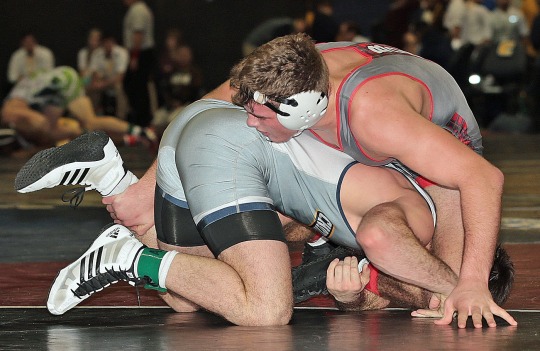
Dakota Geer (top)
30 notes
·
View notes
Photo
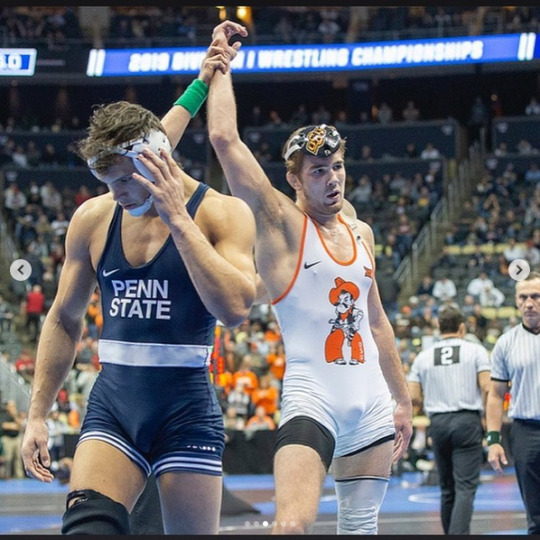
Dakota Geer (https://www.instagram.com/p/BvZXfvfneQA/)
#dakota geer#oklahoma state university#oklahoma state university cowboys#cowboys#wrestling#wrestling singlet#singlet#white#arms up
62 notes
·
View notes
Photo

Bethlehem, PA - Two PIAA State Champions, Dakota Geer (left) of Oklahoma State University, a former Franklin Regional (PA) High School student-athlete, and Jake Jakobsen of Lehigh University, a former Stroudsburg (PA) High School student-athlete, square off during a match at Stabler Arena. Geer won 15-5 but Lehigh upset Oklahoma State 21-20.
0 notes
Text
How Congress can equitably allocate COVID-19 education aid to states
Register at https://mignation.com The Only Social Network for Migrants. #Immigration, #Migration, #Mignation ---
New Post has been published on http://khalilhumam.com/how-congress-can-equitably-allocate-covid-19-education-aid-to-states/
How Congress can equitably allocate COVID-19 education aid to states
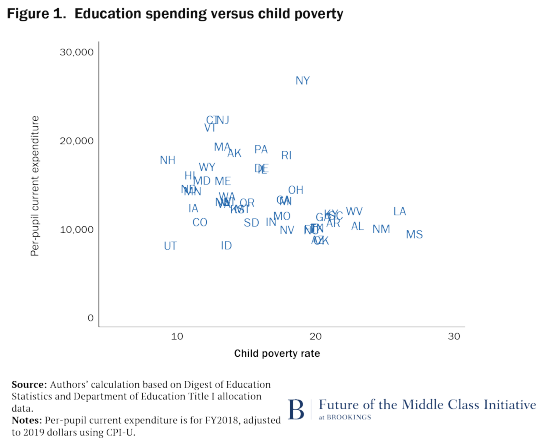
By Sarah Reber, Nora Gordon In this series, we have explained why elementary and secondary education needs a large infusion of federal aid to protect students and promote economic recovery—and why Congress should not use existing formulas like Title I to distribute aid. One reason is that actual or perceived restrictions associated with existing programs could undermine states’ and school districts’ ability to spend federal aid flexibly, in turn undermining their ability to best meet varying and changing needs. In this post, we discuss how Congress can instead choose a simple new formula to allocate a fiscal stabilization fund to states. Lawmakers will also need to decide how funds should be allocated within states to school districts; as prior stabilization packages have demonstrated, they need not use the same approach. We will discuss how funds should be allocated across school districts within states in the next installment to this series.
Congress should direct more aid to poorer states
Lawmakers should design a new formula that sends more money per pupil to states with higher child-poverty rates. Even absent a pandemic, more resources are needed to provide equitable educational opportunities for poor children. The current economic and public health crises only exacerbate this pattern by hitting the poor the hardest. And while we don’t know what the coming school year will hold, distance learning will almost certainly continue for some students or parts of the year. Poor children disproportionately face barriers to accessing distance learning, and public investments could help. Some districts may pursue hybrid approaches—involving some distance learning but also in-person instruction for some students, at some times, in new configurations. As districts explore what this would require, some are reporting the costs of meeting in person with appropriate public health measures in place are prohibitive. In-person school will be particularly important for the children of essential workers—many of whom have low wages—and need a place for their children to learn safely. Despite the greater resource needs of poor students, per-pupil school spending is already lower in states with higher child-poverty rates. While much of the school finance policy discussion focuses on what states do, only the federal government can redistribute spending across state lines—and inequality in spending across states is indeed large. Figure 1 shows the strong pattern of lower school spending in higher-poverty states. Throughout this post, we define the poverty rate as the formula count for Title I (nearly entirely based on poor children) divided by the number of children aged 5-17. For example, current expenditure per-pupil in Arizona ($8,750) is roughly half the level in Massachusetts ($19,300).

All states are affected by the current crisis and the federal government needs to invest in all students. But higher-poverty states have less capacity to withstand these circumstances and need more federal support.
Title I formulas are progressive, but depend on factors other than child poverty
If Congress wants to distribute more aid to poor states, why not expand the main federal compensatory aid program, Title I, or distribute stabilization funds proportional to Title I allocations, as in the CARES Act ESSER Fund? As we have discussed, using Title I undermines local flexibility and creates confusion about the permissible use of funding. But there’s another important reason: Title I allocations do depend on child poverty but also vary considerably for other reasons. Congress can use the number of poor children, rather than Title I allocations, as the key input into the formula determining how much stabilization aid each state receives to more effectively and transparently allocate additional aid to states with more poor children. Figure 2 shows how allocations based on Title I would differ from alternative (hypothetical) approaches that use child poverty directly. Each panel shows the state child-poverty rate on the horizontal axis plotted against the (hypothetical) per-child aid a state would receive for each $10 billion of federal aid under different formulas for allocating fiscal stabilization funds to states. We are not recommending any of the specific approaches in Figure 2, but rather show these to illustrate how Title I allocations differ from per-poor-child allocations.

Panel A illustrates how Title I formulas direct more money per child to poorer states on average, while incorporating other factors as well. States’ shares of Title I and child poverty are not the same. For example, among states with similar child poverty rates (ranging from 11.6% to 12.3%) we see wide variance in allocations proportional to Title I: $104 per child in Colorado, $163 per child in Maryland, and $280 per child in Vermont. Title I formulas depart from straightforward per-poor-child grants for a number of reasons; we discuss only the key differences driving variation across states here. First, Title I formulas incorporate state per-pupil expenditure (SPPE)—the average spending per pupil in the state in recent years, excluding federal funds. States that spend less get less Title I per eligible child; states that spend more get more. Panels B and C of Figure 2 show state-level allocations if $10 billion of federal aid were allocated based on child poverty, rather than Title I. Panel B includes an adjustment for SPPE (but no other components of the Title I formula), and Panel C makes no adjustments, relying solely on child poverty. Comparing Panels A and B shows that the SPPE adjustment alone explains most of the difference between allocations based on Title I (Panel A) and per-poor-child allocations (Panel B). For example, the SPPE adjustment explains why Colorado receives less Title I funding per pupil than Maryland, despite having similar child-poverty rates; Colorado spent significantly less from state and local revenue than Maryland in previous years, so it had a lower SPPE. Title I’s “small state minimum” drives the most noticeable variation—aside from intentional variation due to SPPE, so also present in Panel B—that is visible in Panel A. The small state minimum is why states including Vermont, Wyoming, North Dakota, and Alaska have such high per-child grants relative to their child-poverty rates under a Title-I based allocation (Panel A) compared to an allocation based on the number of poor-children adjusted for SPPE (Panel B). These departures from using only child poverty in Title I are not random, but they are not necessarily desirable for stabilization purposes. For example, the SPPE adjustment is meant to address potential differences in the cost of education across states (assuming that states that spend a lot do so in part because prices, such as teacher salaries, are higher in some places than others). But because poorer states are lower spending on average (see Figure 1), the adjustment makes the allocation of aid less progressive. Small state minimums and hold harmless provisions are the result of years of political wrangling in a decades-old program. A new fiscal stabilization fund does not need to—and should not—carry all this baggage with it.
How has Congress allocated stabilization aid in the past?
We discuss Title I because the CARES Act allocated the bulk of education aid proportional to Title I funding, presumably because Congress wanted to send more money to poorer places and the Title I program is associated with poverty. Other stabilization funds have allocated aid using simpler formulas that assign weights—in different configurations—to states’ shares of the total population, the population aged 5-24, and the population of poor children aged 5-17. Congress has combined stabilization funding for elementary and secondary and higher education; hence, the use of the population aged 5-24. These approaches are summarized in Table 1. The choice of what age group to consider (total population, population ages 5-17, or population aged 5-24) matters much less than the weight put on the number of poor children.
Table 1. How federal funds are awarded to states in federal fiscal stabilization funds
Percent of funding distributed according to state share of … Population aged 5-24 Poor Children aged 5-17 Title I Allocation Total Population Sum May 12 Proposed HEROES Act 61% 39% 0 0 100% 2020 CARES Act Governor’s Fund 60% 40% 0 0 100%
2020 CARES Act Elementary and Secondary School Emergency Relief (ESSER) Fund
0 0 100% 0 100% 2009 American Reinvestment and Recovery Act’s (ARRA) State Fiscal Stabilization Fund 61% 0 0 39% 100%
Figure 3 shows how much each state would get per $10 billion of federal aid using each of the (non-Title I) approaches in Table 1, plotted against its child-poverty rate. The fiscal stabilization package will need to be much larger than $10 billion to fill funding shortfalls; we use $10 billion to illustrate the differences across states.

Both the CARES Act GEER fund (Panel B) and the proposed HEROES fund (Panel C) allocate more aid per child to poorer places, without relying on Title I allocations. By contrast, the SFSF in ARRA distributed funds uniformly based solely on the state’s total population (39%) and its population age 5-24 (61%). Like CARES ESSER (and unlike ARRA), the CARES GEER/HEROES approach directs more federal aid to poorer states. And in marked contrast to ESSER (and like ARRA), it promotes flexibility in how funds are used and avoids incorporating variation in funding based on other aspects of the Title I formulas that are arbitrary, irrelevant, or actively undesirable for stabilization purposes. The CARES GEER/HEROES approach therefore captures the best of both worlds. Because of the specific weights on child poverty and population in CARES GEER and HEROES, the grant amount per child increases less with state-level child-poverty rates with these funding mechanisms than under ESSER. (This is why the slope in Figures 3B and 3C is flatter than that in Figure 1A). If Congress wishes to make federal funds more progressive, it can increase the share of funds allocated based on child poverty rather than child population, while retaining the same basic structure and avoiding use of Title I.
What should the new formula look like?
We recommend a new simple formula similar to those used to allocate the CARES GEER fund and proposed fiscal stabilization fund in HEROES: a weighted function of the number of school-aged children and the number of poor school-aged children who live in the state. Congress needs to choose the weights, and the definition of “school-aged.” In the legislation summarized in Table 1, the formulas use ages 5-24 for the population and 5-17 for the poor population. When one formula covers higher education as well as elementary and secondary, it makes sense to include young adults; in practice, however, the decision to include 18-24 year-olds in the population count makes little difference. The key question is how much weight to put on child poverty versus school-aged population. To illustrate this, we simulated the per-child allocations of aid using the GEER/HEROES approach—using states’ shares of population ages 5-24 and poor kids ages 5-17—to allocate aid, varying the weights put on each. Figure 4 shows how Congress can make the allocation of aid more progressive by putting more weight on the share of poor children in this simple formula. States are ranked from highest to lowest poverty rate. The left panel plots the child-poverty rates, and the right panel plots the per-child allocation the state would receive as the weight put on the share of poor children varies from 0 to 100 (with the remaining weight on the population 5-25). The distribution of aid could be made more or less progressive by adjusting those weights, as the (moving) panel on the right shows. When the weight on child poverty is 0 (so all the weight is on population 5-24), the distribution of aid across states is essentially uniform; it only varies because some states have more 18-24 year-olds relative to the count of poor 5-17 year-olds. When 100% of the funds are allocated according to the number of poor children, poor states receive much larger per-child allocations than lower-poverty states.
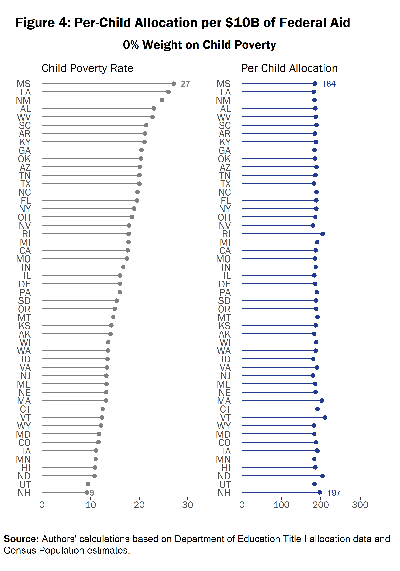
Support states with simple, progressive aid
Congress should follow the example of the CARES Act GEER funds to direct money to states based on their share of the school-aged population and school-aged poor population, rather than based on Title I allocations, which is an imperfect proxy for the number of poor children. Because this approach incorporates child poverty in the formula used to allocate aid, this would be an improvement on the approach taken in ARRA’s SFSF. This framework allows for negotiation over how much more aid Congress wishes to direct to poorer states without incorporating aspects of Title I formulas that are ill-suited to the current situation. Stabilization aid for education should be part of a broader package of federal aid to state and local governments, which is necessary to offset major budget shortfalls. Aid should also continue as long as the recession lasts; Congress should provide several years of stabilization aid for education. And including automatic stabilizers in other programs, for example, by tying the federal matching rate for Medicaid and the Children’s Health Insurance Program to state unemployment rates, would also help ensure federal support for states lasts long enough. This will improve the fiscal position of states and help protect all of the services funded by state governments, including education. The authors did not receive financial support from any firm or person for this article or from any firm or person with a financial or political interest in this article. The authors are not currently officers, directors, or board members of any organization with a financial or political interest in this article.






0 notes
Text
Governors’ races have become contests between bajillionaires
The Economist, Oct 19th 2017
CHICAGO--Though the primary is not until next March, the election to be the next governor of Illinois is already on track to become the most expensive in state political history, overtaking the $280m fight for the governorship of California in 2010 between Jerry Brown and Meg Whitman, a billionaire businesswoman. Election spending in Illinois has increased by 741% this year compared with the same period in the previous election, according to the Illinois Campaign for Political Reform, an NGO. The candidates burned through $15.6m in the past three months, led by J.B. Pritzker, a self-funded billionaire businessman running for the Democrats, who splashed out $11.1m, mostly on television advertising, followed by Bruce Rauner, the self-funding Republican incumbent, who spent $2.6m, even though he has not confirmed yet that he is running for re-election. Mr Rauner and Mr Pritzker have so far raised just under $100m between them.
Though an extreme example, Illinois is no outlier. More and more very wealthy men are running for and winning office as state governors. Tennessee’s Bill Haslam, West Virginia’s Jim Justice, Florida’s Rick Scott, Kentucky’s Matt Bevin, Minnesota’s Mark Dayton, Nebraska’s Peter Ricketts, Pennsylvania’s Tom Wolf, Michigan’s Rick Snyder, North Dakota’s Doug Burgum and Arizona’s Doug Ducey all have a net worth measured in the tens, and in some cases hundreds, of millions. The richest is Mr Haslam, a multibillionaire whose father founded Pilot Flying J, a chain of petrol stations and convenience stores. Mr Justice, a coal billionaire, is the richest man in the state he governs.
America has had wealthy governors before--think of Nelson Rockefeller and Franklin Roosevelt, both of whom governed New York. But their proliferation is new. In part this simply reflects increasing income disparity in the country, says John Geer of Vanderbilt University in Tennessee. Candidates with little money are disadvantaged by having to spend more time raising funds from donors to whom they are then beholden. One of President Donald Trump’s most popular campaign lines--that he was too rich to be bought by special interests--works in state elections too. Given the opacity of money in politics, perhaps voters find self-funding campaigns to be refreshingly transparent.
Whatever the reason, the result is that in many states there is now a wealth primary before the electoral primary, says Kent Redfield of the University of Illinois. Big money tends not only to limit the field, but to catapult candidates who have never run for anything before to the front of the race. Florida’s Rick Scott would probably not have won his Republican primary against Bill McCollum, a candidate with a proven track record, had he not spent $50m of his own dosh. The same is true of Mr Rauner, another political neophyte, who defeated Pat Quinn, the incumbent Democratic governor, and personally contributed $28m to the $65.3m, or $36 a vote, that his campaign cost.
How good are self-funding governors at governing? Such candidates often promise to run their states like a business, but their success can depend more on whether they have previous political experience. The pragmatic Mr Haslam is well-liked in Tennessee even by Democrats, and boasts an approval rating of around 60%. He was a two-term mayor of Knoxville before he ran for governor.
Michigan’s Mr Snyder and Illinois’s Mr Rauner, on the other hand, are among the least popular governors. Mr Snyder has not recovered from the public-health crisis caused by lead-contaminated water in Flint. Mr Rauner has been unable to govern effectively with the Democrat-controlled legislature. As a result, the state of Illinois’s finances have gone from critical to catastrophic, with unpaid bills amounting to $15bn and the state paying as much as 10% interest on some of its debt.
Some newly minted governors have found their first encounters with a hard-nosed political press corps to be a shock. In some cases this makes them less willing to talk, which in turn leads to even less favourable coverage--a lesson Mr Rauner, who is now more talkative, learned the hard way in Illinois. Private wealth will not be enough to win him re-election next year, especially as Mr Pritzker is much richer.
One candidate who flunked the yacht primary in Illinois was Ameya Pawar, an alderman who said on October 12th that he was dropping out of the race for the Democratic nomination because he could not compete with his rich rivals. “We raised $830,000 in ten months, which would be a competitive number in any other race,” says Mr Pawar, the 37-year-old son of Indian immigrants, who was re-elected in his ward with 83% of the vote. “But our politics today is about wealthy people funding wealthy candidates.”
1 note
·
View note
Text
Mattys - 2018
I try to do my own version of the Emmys every year, and these are the results for 2018. The eligibility requirement for shows is, as always, having to finish half of a season before May 31st. Winners are bolded.

Outstanding Drama Series
The Americans
Claws
The Expanse
The Good Fight
Halt and Catch Fire
Killing Eve
Queen Sugar
Outstanding Lead Actor in a Drama Series
Frank Grillo, “Kingdom”
Cilian Murphy, “Peaky Blinders”
Matthew Rhys, “The Americans”
Giovanni Ribisi, “Sneaky Pete”
J.K. Simmons, “Counterpart”
Dan Stevens, “Legion”
Outstanding Lead Actress in a Drama Series
Christine Baranski, “The Good Fight”
Jodie Comer, “Killing Eve”
Claire Foy, “The Crown”
Tatiana Maslany, “Orphan Black”
Elisabeth Moss, “The Handmaid’s Tale”
Niecy Nash, “Claws”
Keri Russell, “The Americans”

Outstanding Supporting Actor in a Drama Series
Noah Emmerich, “The Americans”
Tom Hardy, “Peaky Blinders”
Jason Mitchell, “The Chi”
Noah Schnapp, “Stranger Things”
Matt Smith, “The Crown”
Jonathan Tucker, “Kingdom”
Outstanding Supporting Actress in a Drama Series
Lena Headey, “Game of Thrones”
Cush Jumbo, “The Good Fight”
Bianca Lawson, “Queen Sugar”
Thandie Newton, “Westworld”
Yvonne Strahovski, “The Handmaid’s Tale”
Constance Zimmer, “UnREAL”
Outstanding Guest Actor in a Drama Series
David Haig, “Killing Eve”
Anthony Hopkins, “Westworld”
Thomas Jane, “The Expanse”
Gerald McRaney, “This Is Us”
David Tennant, “Marvel’s Jessica Jones”
Jonathan Tucker, “Westworld”

Outstanding Guest Actress in a Drama Series
Joy Brunson, “This Is Us”
Andrea Martin, “The Good Fight”
Jane Lynch, “The Good Fight”
Diana Rigg, “Game of Thrones”
Uma Thurman, “Imposters”
Alison Tolman, “Good Girls”
Outstanding Directing for a Drama Series
The Americans, S06E10 - “START”
The Crown, S02E08 - “Dear Mrs. Kennedy”
The Good Fight, S02E12 - “Day 485”
Legion, S02E11 - “Chapter 19”
Kingdom, S03E10 - “Lie Down in the Light”
Peaky Blinders, S04E01 - “The Noose”
Outstanding Writing for a Drama Series
The Americans, S06E10 - “START”
Counterpart, S01E07 - “The Sincerest Form of Flattery”
The Good Fight, S02E12 - “Day 485”
Halt and Catch Fire, S04E08 - “Goodwill”
Killing Eve, S01E05 - “I Have A Thing About Bathrooms”
Legion, S02E06 - “Chapter 14”
Outstanding Comedy Series
Brockmire
Crazy Ex-Girlfriend
G.L.O.W.
The Good Place
Happy!
The Marvelous Mrs. Maisel
One Day at a Time
Outstanding Lead Actor in a Comedy Series
Hank Azaria, “Brockmire”
Ted Danson, “The Good Place”
Chris Geere, “You’re the Worst”
Bill Hader, “Barry”
Christopher Meloni, “Happy!”
Chris O’Dowd, “Get Shorty”
Outstanding Lead Actress in a Comedy Series
Pamela Adlon, “Better Things”
Rachel Bloom, “Crazy Ex-Girlfriend”
Alison Brie, “G.L.O.W.”
Rachel Brosnahan, “The Marvelous Mrs. Maisel”
Aya Cash, “You’re the Worst”
Andrea Savage, “I’m Sorry”

Outstanding Supporting Actor in a Comedy Series
John Early, “Search Party”
Marc Maron, “G.L.O.W.”
Lance Reddick, “Corporate”
Ray Romano, “Get Shorty”
Tony Shalboub, “The Marvelous Mrs. Maisel”
Henry Winkler, “Barry”
Outstanding Supporting Actress in a Comedy Series
Alex Borstein, “The Marvelous Mrs. Maisel”
D’Arcy Carden, “The Good Place”
Donna Lynne Champlin, “Crazy Ex-Girlfriend”
Jane Levy, “There’s… Johnny!”
Judith Light, “Transparent”
Rita Moreno, “One Day at a Time”
Outstanding Guest Actor in a Comedy Series
Raymond J. Barry, “You’re the Worst”
Jason Mantzoukas, “The Good Place”
Robert S. Powell III, “Atlanta”
Keanu Reeves, “Swedish Dicks”
Wallace Shawn, “The Marvelous Mrs. Maisel”
Paul Welsh, “Crazy Ex-Girlfriend”

Outstanding Guest Actress in a Comedy Series
Jane Lynch, “The Marvelous Mrs. Maisel”
Niecy Nash, “A.P. Bio”
Carrie Preston, “Brockmire”
June Squibb, “I’m Sorry”
Maya Rudolph, “The Good Place”
Phoebe Tyers, “Search Party”
Outstanding Directing for a Comedy Series
Atlanta, S02E06 - “Teddy Perkins”
Better Things, S02E10 - “Graduation”
Crazy Ex-Girlfriend, S03E04 - “Josh’s Ex-Girlfriend is Crazy.”
G.L.O.W., S01E10 - “Money’s in the Chase”
Happy!, S01E06 - “The Scrapyard of Childish Things”
The Marvelous Mrs. Maisel, S01E01 - “Pilot”
Outstanding Writing for a Comedy Series
Atlanta, S02E06 - “Teddy Perkins”
Barry, S01E07 - “Chapter Seven: Loud, Fast and Keep Going”
Better Things, S02E06 - “Eulogy”
The Good Place, S02E01 - “Everything is Great!”
One Day at a Time, S02E13 - “Not Yet”
You’re The Worst, S04E03 - “Odysseus”
Outstanding Limited Series
The Alienist
American Crime Story: The Assassination of Gianni Versace
Howards End
The Last Tycoon
The Sinner
Waco
Outstanding Lead Actor in a Limited Series or Movie
Darren Criss, “American Crime Story”
Jeff Daniels, “The Looming Tower”
Jared Harris, “The Terror”
Terrence Howard, “Electric Dreams: Real Life”
Taylor Kitsch, “Waco”
Jimmy Tatro, “American Vandal”

Outstanding Lead Actress in a Limited Series
Hayley Atwell, “Howards End”
Jessica Biel, “The Sinner”
Dakota Fanning, “The Alienist”
Sarah Gadon, “Alias Grace”
Sarah Lancashire, “National Treasure: Kiri”
Cristin Milioti, “Black Mirror: U.S.S. Callister”
Outstanding Supporting Actor in a Limited Series
Paul Bettany, “Manhunt: Unabomber”
Cody Fern, “American Crime Story”
Matthew Macfadyen, “Howards End”
Adam Nagaitis, “The Terror”
Tahar Rahim, “The Looming Tower”
Jimmi Simpson, “Black Mirror: U.S.S. Callister”
Outstanding Supporting Actress in a Limited Series
Jennifer Beals, “The Last Tycoon”
Vera Farmiga, “Electric Dreams: Kill All Others’
Romola Garai, “The Miniaturist”
Judith Light, “American Crime Story”
Janelle Monáe, “Electric Dreams: Autofac”
Sharon Stone, “Mosaic”

Outstanding Directing for a Limited Series
The Alienist S01E06 - “Ascension”
American Crime Story S02E01 - “The Man Who Would Be Vogue”
Black Mirror S04E01 - “U.S.S. Callister”
The Last Tycoon S01E09 - “Oscar, Oscar, Oscar”
Philip K. Dick’s Electric Dreams S01E02 - “Impossible Planet”
Waco S01E06 - “Day 51”
Outstanding Writing for a Limited Series
American Crime Story S02E04 - “House by the Lake”
Black Mirror S04E06 - “Black Museum”
The Looming Tower S01E10 - “9/11”
Manhunt: Unabomber S01E06 - “Ted”
Philip K. Dick’s Electric Dreams S01E08 - “Autofac”
The Sinner S01E01 - “Part I”
FX/FXX, Amazon Prime and Netflix are among the top contenders with 25, 17 and 17 nominations respectively. The shows with the most nominations in drama, comedy and limited are pictured during the list.
1 note
·
View note
Text
President’s List Spring 2017
NATCHITOCHES – Five hundred and seventy-three students were named to the Spring 2017 President’s List at Northwestern State University. Students on the list earned a grade point average of 4.0. Those named to the President’s List listed by hometown are as follows.
Abbeville – Jabain August, Kayla Marceaux;
Abita Springs – Harold Simmons;
Alexandria – Lewis Davis, Dalan Dorsey, Teresa Foshee, William Griffin, Martha Hopewell, Jaliyah Jasper, Micaelee Jeansonne, Spencer Jones, Luke Laborde, Rachel Lavergne, Allyson McCowan, Ashley Mitchell, Katherine Mitchell, Wade Morris, Benjamin Murphy, Emilye Netherland, Ryan Ware, Eric Weinzettle, Elaina Williams;
Alto, Texas – Cody Birdwell;
Anacoco – Kristen Eusay, Benjamin Jackson, Haley Jett, Kayli O’Toole, Cassandra Osborne, Lindsay Plummer;
Athens – Alejandra Monjardin;
Baldwin – Gerianna Lyons;
Ball – Sarah Morgan, Payton Pilgrim, Megan Wakefield;
Barksdale AFB – Heather McGurn, Tova Volcheck;
Basile – Betsi Smith;
Bastrop – Emily Carson, Katie Stanley;
Baton Rouge – Ramya Koritala, Stephanie Leger, Madalyn Mullins, Dakota Newman, Markeisha Patterson, Colleen Reese, Maria Rome;
Bayside, Nova Scotia, Canada – April Trowbridge;
Baytown, Texas – Abby Gardea;
Beaumont, Texas – Dustin Burns;
Belgorod, Russia – Elizaveta Gerasimova
Belle Chasse – Alexandria Hughes, Megan Jenkins;
Belmont – Cade Cramer;
Benton – Nicholas Clay, Elizabeth Jones, Jessica O’Neal, Maegan Ross, Jenna Smith;
Bossier City – Shelby Ansley, Sara Blankenship, Alexander Butler, Austin Coffey, Amanda Davis, Taylor Freeman, Joshua Greer, Ashlynn Henderson, Oai Lee Huynh, Nourain Jamhour, Tiffany Johnson, Emily Juarez, Chelsea Laverdiere, Mary Katheryn Lummus, Hang Lian, Myra Martinez, Alexa McKnight, Madison Morris, Yadira Ocanas, Shelby Peebles, Taylor Powell, Jerdine Robinson, Madison Rowland, Kevin Smithey, James Taylor, Kellie Toms, Gennadiy Vavrenyuk, Jordan Wilcox;
Boyce – Curtis Fennell, Carlie Gauthier, Hannah Miller, Lachan Misner;
Breaux Bridge – Shayla James;
Broussard – Amber Potier, Amelia Soileau;
Buda, Texas – Kathryn Wristen;
Bunkie – Emily Arnaud;
Burleson, Texas – Addison Pellegrino, Donato Susca;
Bush – Ashleigh Ranatza;
Campti – Bridget DaGama, Floyd Turner;
Cartagena, Colombia – Jorge Ojeda Munoz, Paula Martinez Marrugo;
Catagena Bolivar, Colombia – Aura Hernandez Canedo;
Centreville, Miss. – Taylor Priest;
Cheneyville – Katelyn Baronne;
Chopin – Daisy Delrie, Mary Guimaraes;
Church Point – Kristian Burrow, Jennifer Thibodeaux;
Citrus Springs, Florida – Megan McDonald;
Colfax – Angela McCann, Katie Woodard;
Converse – Heather Bryson, Ashley Forgues Brock, Wade Hicks, Elaina Richardson, Triston Waldon;
Cottonport – Christopher Juneau;
Coushatta – Sydney Anderson, Caroline Doughty, Jon Hester, Baley McAlexander, Shalondria Rainey, Jacob Shaver, Macie Wood;
Covington – Kelsey Cassidy, Andrea Mier, Kenneth Sears, Crystal Tucker;
Creole – Brooklyn Frerks;
Cut Off – Zachary Breaux;
Cypress, Texas – Alexis Warren, Mercedes Wiles;
DeRidder – Brandy Bryant, Sara Bishop, Lauren Callis, Karli Chambers, Jennifer Jarell-Bell; John Pearce, Kristina Pfantz, Claudia Rouleau, Jacqueline Rushford;
Delhi – Shelly Godard;
Denham Springs – Tiffany Duval, Lyndsey Girlinghouse, Stacy McClendon, Amy Thomas;
Des Allemands – Brooke Verda;
Desoto, Texas – Janet Jackson;
Destrehan – Hannah Boquet, Patrick Juneau, Shannon Walsh, Stephanie Webre;
Deville – Aaron Belgard, Dana Davis, Candice Dryden, Kenedy Lampert, Alyssa Roberts;
Dodson – Josie Greer;
Duncanville, Texas – Fernando Zuniga;
Duson – Desmond Prejean;
East Windsor, N.J. – Andreia Martins;
El-Rehab, Cairo, Egypt – Arwa Hezzah;
Endicott, N.Y. – Tonya Rackett;
Eros – Alecia Smith;
Eunice – Victoria Hebert, Victoria McGee;
Ferriday – Elizabeth Guerrero, Deyon White;
Florence, Miss. – Stephanie Bailey;
Florien – Cullen Hopkins, Caroline Matthews, Megan Wilmore;
Forest – David Stephens;
Forest Hill – Leslie Chavez, Charli Stanley;
Forney, Texas – Jayden Wheeler;
Fort Polk – Jamie Curtis, Robyn Foxworth, Shaunda Gordon, Kelsey Hart, Kenisha Smith, Sandra Valdez;
Franklin – Mariah Pellerin;
French Settlement – Tommie Espy;
Frierson – Brittany Furrow;
Garland, Texas – Alec Horton;
Geismar – Emilee Hawkins;
Georgetown – Brittany Farris;
Glen Burnie, Md. – Kathern Speicher;
Goldana – MacKenzie Johnson, Harley Godwin;
Gonzales – Katelyn Marchand, Molly Moran;
Grand Cane – Emily Miller;
Gray -- Tevyn Johnson;
Grayson -- Alicia Foy;
Greer, S.C. – Carola Colon;
Gretna – Brandi Bealer;
Hallsville, Texas – Emma Hawthorne;
Hammond – Blaike Peters;
Harleton, Texas – Madalyn Evers;
Hartselle, Ala. – Teresa Smith;
Harvey – Taylor Bourgeois, Jessica Love, Jessica Rousset;
Hassik – Vasquez Narvaez;
Haughton – Jordge Cardenas Nunez, Michelle Feaster, Connor Geer, Aly Hesson, Alexis Hoeltje, Lucas Moncla, Jamie Phillips, Logan Turner, Bridgette Wilson, Hunter Woods;
Heath, Texas – Megan Lohmiller;
Hermon, Maine – Allessa Oakes;
Hineston – Tylee Busby; Madison Morrison;
Houma – Shelby Glynn, Blair Kramer, Sarah Lajaunie, Chelsea Thibodeaux;
Houston, Texas – Kendall Westfall,
Huntington, Texas – Travis Carrell;
Huntsville, Ala. – Elizabeth Gilliam;
Independence – Kaylan Showers;
Iota – Katie Latiola;
Iowa – Nicholas Fisher;
Jena – Dustin Decker, Haley Decker, Tyler Thomas;
Jennings – Janee Charles, Wesley Simien;
Jonesboro, Ark. – Alanna Benoit;
Jonesville – Coleen Cagle, Shana Jefferson, Kameron Stevenson;
Kentwood – Jenna Morris;
Kings Mountain, N.C. – Ashley Counts;
Kaplan – Gabriel LeMoine;
Keithville – Alexis Britt, Rachel Opbroek;
Kendrick, Okla. – Chelsey Goldsmith;
Kenner – Christina Arrechavala, Brooke Petkovich;
Kiev, Ukraine – Kateryna Avram;
Kinder – Stewart Wheeler;
Kingwood, Texas – Eric Piccione;
Lafayette – Taylor Aucoin, Anjelique Duplechin, Emile Lege, Jacklyn Marr;
Lake Arthur – Layne Watkins;
Lake Charles – Laura Cornish, Krista Dixon, Karley Hebert, Alyce Jimney, Rebekah Keller, Jordan Reich;
Larose – Eric Bourg, Nicholas Hebert;
Lawtell – Karoline Guidry;
Lecompte – Hannah Glaze;
Leesville – Destin Bennett, Kelly Bishop, Alexis Bynog, Charlotte Cassin, Caitlin Deon, Brianna Easterling, Ovina Forque, Jessica Gabor, Emily Jackson, Zachary Keeton, Jessica Mango, Miranda Mize, Brooke Perkins, Victoria Perkins, Danielle Smyth, Haley Tucker, Jacob Underwood, Lakyn Ward, Matthew Ward, Jessica Taylor;
Lena – Tracy Benjamin, Nathaniel Dubois;
Logansport – Trenton Timmons;
Longview, Texas – Samantha Morris;
Luling – Alexis Rice;
Lutcher – Rebekah Taylor;
Madisonville – Ashley Johansen. Christopher Snow, Jensen Volz;
Mandeville – Nina DeSmith, Michelle Price;
Mangham – Rebekah Aultman;
Mangilao, Guam – Maria Magdalena Bansil;
Mansfield – Hannah Hughes;
Mansura – Renada Jenkins;
Many – Hannah Allen, Chelsea Beasley, Jacob Ellis, Nicholas Ezernack, Angelica Galban, Sarah Heard, Abby Hinds, Heidi Knight, Emily Leone, Chastity McCrory, Jonathan Pilcher, Sabrina Ross, Samantha Simmons, John Sullivan;
Marble Falls, Texas – Sarah Lewis;
Marksville – Emily Ryan;
Marthaville – Kelsey Claspill, Hanna Pardee, Lirette Thomas;
McKinney, Texas – Beatrice Attura, Anne Repp;
Melrose – Molly Dickerson;
Meraux – Dana Methvin;
Metairie – Kaitlyn Arena, Ariel Landry, Shawn Lawler, Cameron Mayfield, Lisa Roberson;
Midland, Texas – Channing Burleson;
Midlothian, Va. – Tatijana Rangel-Ribiero;
Minden – Amanda Curry, Aubry Dennis, Ryan Harmon;
Mississauga, Ontario, Canada – Kayla Bomben;
Monroe – Kianisha Dillard, Anna Rogers, Savanna Whitten, Gail Wilson;
Montgomery, Texas – Jake Rice, Kyle Swanson;
Mooringsport – Jacklyn Dublin;
Morgan City – Jeremy Orgeron;
Morse – Kylan Poullard;
Mt. Albert, Canada – Erin Sitarz;
Muleshoe, Texas – Caitlyn Barber;
Murrieta, Calif. – LaQuitta Wilkins;
Natchitoches – Tyler Anderson, Francisco Ballestas-Sayas, Kayla Bordelon, Harvey Briggs, Deasia Burrell, Daniel Coffey, Fabian Correa Guette, Jessica Cross, Mazie Dubois, Kirsten Fontenot, Carlos Gomez Garcia, Angel Greer, Hannah Haigh, Ashytn Hare, Zachary Heard, Ashlyn Hogan, Jennifer Johnson, Shayla Johnson, Jeremy Jones, Emilie King, Florence Kilgore, James Lake, Lindsay Lee, Robert Lee, Heather Lockwood, Alba Maloff, Thomas Matuschka, Marissa Oster, Abigail Poe, Jonah Poe, Kaytie Proctor, Brandy Ranel, Amelia Ryland, Emily Salter, Josie Stamey, Faith Stanfield, Nicholas Swank, Madeline Taylor, Eva Venzant, Barbara Vercher-Smith, Richard Walks, Madysen Watts, Ryan Wright;
New Iberia – Kristine Trahan;
New Llano – Reaz Khan, Matreena Sablan;
Newark, Del. – Sabri Thompson;
Noble – James Connella, James Curtis, Harlee Possoit, Breana Remedes;
Oak Grove – Heather Allen;
Oakdale – Katelyn Johnson, Kirstin Richard, Mary Wharton;
Oconomowoc, Wisc. – Natalie Jaeger;
Opelousas – Tracey Antee, Toria Smith, Erika Stanford;
Pelican – Justin Cooper, Mary Myers;
Pioneer – Moesha Smith;
Pineville – Raegan Brocato, Snow Buckley, Mason Caubarreaux, Kaylee Chronister, Raymond Fletcher, Lacey Hebron, Morgan Humphries, Michael Martin, Ashlee Mitchell, Stacey Ramsey, Katie Rayburn, Jodie Roberts, Candice Smith, Allison Williams;
Pitkin – Aimee Calmes, Mattie Stewart;
Plain Dealing – Jacob Horton;
Plaquemine – Ma Kayla Washington;
Pleasant Hill – Samatha Davis, Laura Spann;
Pollock – Zackary Phillips;
Pontchatoula – Brandon Dalon, Marisa Durand, Raley Pellittieri;
Prairieville – Jakalyn Hills, Caitlin Miller;
Provencal – Taylor Craft, Kara Gandy, Bailey Scarbrough;
Quitman – Katheryn Gaulden;
Raeford, N.C. – Brittney Carpenter;
Rayne – Meraiah Young;
Ringgold – Joseph Hays, Lauren Nelson;
River Ridge – Emily Digangi;
Robeline – Bergen Oge, Courtney Rachal, Fawn Slaughter, Jeffrey Watley, Caleb Wester;
Rocklin, Calif. – Madeline Mason
Rosepine – Summer Cooley
Rostov-on-Don, Russia – Vladislava Litvinova;
Ruston – Karenthia Crosby Onwudebe;
Sachse, Texas – Ryan Verloin DeGruy;
Saint Francisville – Jordan Bringedahl;
Saint Rose – Alexis Mancuso;
Sanford, N.C. – Joseph Tippit;
Saumur Maine et Loire, France – Yohann Yjjou
Schriever – Holly Cantrelle;
Scott – Katelyn Kidder
Seattle, Wash. – Lauren Agan;
Shelbyville, Texas – Sarah Ryder;
Shongaloo – Kayla Mouser;
Shreveport – Lindsey Adkins, Karianna Baker, Brittany Barnes, Angelica Bartlett, Ezar Bess, Hannah Bolton, Crystal Brown, Erin Brown, Brianna Burke, Nicollette Carswell, Phillip Clark, Crystal Claunch, Celeste Clifton, Hannah Crnkovic, Emily Dean, Kaitlyn Doyal, Jackson Driggers, Sarah Dunn, Reagan Escude, Lashayla Ester, Ronald Evans, Irishia Finister, Tyler Gardner, Nickolas Juneau, Adrianne Kelly, Emalee Kennon, Cole Laird, Bih-Lih Lau, Erin LeClair, Jaylon Lewis, Casey Long, Joycelyn McConnell, Rici McDonald, James McGrail, Rosemary McMaster, Madison Milligan, Hannah Nicholls, Hayden Pilcher, Taylor Poleman, Emily Rankin, Anna Richardson, Zachary Sanders, Jarred Sepulvado, Kathryn Shrader, Tyler Smith, Destini Sweet, Rachel Taylor, Michael Thrower, JeVannica Williams, Suzanne Williams Tiffani Williams, Jonathan Zavalydriga;
Simsboro – Autumn Smith;
Slaughter – Ciara Gibbs;
Slidell – Claire Harvey, Jourdan Waddell;
Spain – Judit Castillo Gargallo;
Spring, Texas – Victoria Harris;
St. Mars lo Briere – Marion Cormier;
St. Martinville – Alli Douet;
Stockbridge, Ga. – Alisa Newsome;
Stonewall – Brooke Meade;
Sulphur – Tina Honea, Elizabeth Perez;
Summerfield – Mackenzie Scriber;
Sunset – Emma Warren;
Tatum, Texas – Randall Sullivan;
Temple, Texas – Weston Scholten;
Texarkana, Texas – Karlie Purdy;
The Woodlands, Texas – Robyn Beatty;
Thibodaux – Nia Walker;
Tomball, Texas – Anthony Lucas;
Trout – Harley Lisenby;
Vinton – Emily Walter;
Waco, Texas – Haylie Hickman;
Waskom, Texas – Mary Alexander;
Waukomis, Okla. – Colby Koontz;
West Monroe – Abigail Beck, Brandy Chapman, Maggie Harris, Kayla Telano;
Winnfield – John Collins, Mia County, Andrew Harrel, Rebecca Hodnett, Anissa Jones, Kelsey Jordan, Brittany Parker;
Winnipeg, Canada – Tyra Duma;
Woodworth – Elizabeth Bonnette, Taylor Henry, Ashley Kennedy-Rowell;
Wylie, Texas – Kylie Nodorft, Grace Punch, Kali Roberts;
Zwolle – Cheyanne Ebarb, Holden Rivers;
2 notes
·
View notes
Text
Governors’ races have become contests between bajillionaires
THOUGH the primary is not until next March, the election to be the next governor of Illinois is already on track to become the most expensive in state political history, overtaking the $280m fight for the governorship of California in 2010 between Jerry Brown and Meg Whitman, a billionaire businesswoman. Election spending in Illinois has increased by 741% this year compared with the same period in the previous election, according to the Illinois Campaign for Political Reform, an NGO. The candidates burned through $15.6m in the past three months, led by J.B. Pritzker, a self-funded billionaire businessman running for the Democrats, who splashed out $11.1m, mostly on television advertising, followed by Bruce Rauner, the self-funding Republican incumbent, who spent $2.6m, even though he has not confirmed yet that he is running for re-election. Mr Rauner and Mr Pritzker have so far raised just under $100m between them. In the sort of twist that seems straight from a plot by Armando Iannucci, the lion’s share ($50m) was given by Governor Rauner to a group called Citizens for Rauner. Mr Pritzker gave his campaign a modest $28m.
Though an extreme example, Illinois is no outlier. More and more very wealthy men are running for and winning office as state governors. Tennessee’s Bill Haslam, West Virginia’s Jim Justice, Florida’s Rick Scott, Kentucky’s Matt Bevin, Minnesota’s Mark Dayton, Nebraska’s Peter Ricketts, Pennsylvania’s Tom Wolf, Michigan’s Rick Snyder, North Dakota’s Doug Burgum and Arizona’s Doug Ducey all have a net worth measured in the tens, and in some cases hundreds, of millions. The richest is Mr Haslam, a multibillionaire whose father founded Pilot Flying J, a chain of petrol stations and convenience stores. Mr Justice, a coal billionaire, is the richest man in the state he governs.
America has had wealthy governors before—think of Nelson Rockefeller and Franklin Roosevelt, both of whom governed New York. But their proliferation is new. In part this simply reflects increasing income disparity in the country, says John Geer of Vanderbilt University in Tennessee. Candidates with little money are disadvantaged by having to spend more time raising funds from donors to whom they are then beholden. One of President Donald Trump’s most popular campaign lines—that he was too rich to be bought by special interests—works in state elections too. Given the opacity of money in politics, perhaps voters find self-funding campaigns to be refreshingly transparent.
Whatever the reason, the result is that in many states there is now a wealth primary before the electoral primary, says Kent Redfield of the University of Illinois. Big money tends not only to limit the field, but to catapult candidates who have never run for anything before to the front of the race. Florida’s Rick Scott would probably not have won his Republican primary against Bill McCollum, a candidate with a proven track record, had he not spent $50m of his own dosh. The same is true of Mr Rauner, another political neophyte, who defeated Pat Quinn, the incumbent Democratic governor, and personally contributed $28m to the $65.3m, or $36 a vote, that his campaign cost.
People for Pritzker
How good are self-funding governors at governing? Such candidates often promise to run their states like a business, but their success can depend more on whether they have previous political experience. The pragmatic Mr Haslam is well-liked in Tennessee even by Democrats, and boasts an approval rating of around 60%. He was a two-term mayor of Knoxville before he ran for governor.
Michigan’s Mr Snyder and Illinois’s Mr Rauner, on the other hand, are among the least popular governors. Mr Snyder has not recovered from the public-health crisis caused by lead-contaminated water in Flint. Mr Rauner has been unable to govern effectively with the Democrat-controlled legislature. As a result, the state of Illinois’s finances have gone from critical to catastrophic, with unpaid bills amounting to $15bn and the state paying as much as 10% interest on some of its debt.
In Florida, Mr Scott has not managed to do much of what he promised, such as expanding the state’s economic-development agencies or securing big tax cuts, says Aubrey Jewett of the University of Central Florida. The Republican-controlled legislature still considers him an amateur. He is uncomfortable giving speeches or presiding over public ceremonies. Some newly minted governors have found their first encounters with a hard-nosed political press corps to be a shock. In some cases this makes them less willing to talk, which in turn leads to even less favourable coverage—a lesson Mr Rauner, who is now more talkative, learned the hard way in Illinois. Private wealth will not be enough to win him re-election next year, especially as Mr Pritzker is much richer.
Anchors away
One candidate who flunked the yacht primary in Illinois was Ameya Pawar, an alderman who said on October 12th that he was dropping out of the race for the Democratic nomination because he could not compete with his rich rivals. “We raised $830,000 in ten months, which would be a competitive number in any other race,” says Mr Pawar, the 37-year-old son of Indian immigrants, who was re-elected in his ward with 83% of the vote. “But our politics today is about wealthy people funding wealthy candidates.” Other aspirants to the governor’s mansion should not completely despair, though, for there remains another route to the front of the line. Chris Kennedy, a scion of the country’s most famous political dynasty, is a contender in Illinois too.
This article appeared in the United States section of the print edition under the headline "The yacht primary"
http://ift.tt/2yzaoan
0 notes
Text

Dakota Geer
25 notes
·
View notes
Photo

Dakota Geer (https://www.instagram.com/p/B2xWevrlMBV/)
#dakota geer#oklahoma state university#oklahoma state university cowboys#cowboys#wrestling#wrestling singlet#singlet#orange
28 notes
·
View notes
Text
Noticias de series de la semana: 'Russian Doll', renovada
Renovaciones
Netflix ha renovado Russian Doll por una segunda temporada
Comedy Central ha renovado Corporate por una tercera y última temporada
Netflix ha renovado Love, Death + Robots por una segunda temporada
Spectrum ha renovado L.A.'s Finest por una segunda temporada
Noticias cortas
Paul Wesley volverá a Tell Me a Story para su segunda temporada, esta vez interpretando a Tucker, un novelista que pasa las noches en vela en una cabaña en el bosque tratando de demostrar que es suficientemente bueno para su bella prometida. Esta temporada adaptará La Bella y la Bestia, La bella durmiente y Cenicienta.
Erica Gimpel (Trish) será regular en la segunda temporada de God Friended Me.
Steven Ogg (Pike) será regular en la segunda temporada de Snowpiercer.
La cuarta y última temporada de The Good Place tendrá catorce episodios.
Incorporaciones y fichajes
Geena Davis (Thelma & Louise, The Accidental Tourist) será recurrente en la tercera temporada de GLOW como Sandy Devereaux St. Clair, antigua showgirl y ahora directora de entretenimiento del hotel y casino Fan-Tan en Las Vegas.
Daniel Radcliffe (Harry Potter, Swiss Army Man) se une al episodio musical de Unbreakable Kimmy Schmidt.
Elizabeth Banks (30 Rock, Wet Hot American Summer) será Jill Ruckelshaus, una republicana que fue elegida por el presidente Ford para avanzar en los derechos de las mujeres, en Mrs. America.
Ashley Tisdale (High School Musical) sustituye a Bonnie Dennison como Jenny, hija de Carol (Patricia Heaton), en Carol's Second Act.
Sophia Lillis (Sharp Objects, It), Kathleen Rose Perkins (Episodes), Wyatt Olef (Guardians of the Galaxy), Sofria Bryant (The Good Wife), Aidan Wojtak-Hissong (Falling Water) y Richard Ellis (Veronica Mars) protagonizarán I Am Not Okay With This.
Imelda Staunton (Pride, Harry Potter), Russell Tovey (Looking, Years and Years), Stephen Rea (The Honourable Woman, Counterpart), Francesca Annis (Dune, Lillie), Claudie Blakley (Lark Rise to Candleford, Grantchester) y Lydia Leonard (Gentleman Jack, Absentia) protagonizarán Flesh and Blood, sobre tres hermanos adultos (Tovey, Blakley y Leonard) cuya madre Vivien (Annis), de setenta años y recién enviudada, confiesa estar enamorada de un nuevo hombre (Rea). Staunton dará vida a Mary, la vecina de Vivien. Completan el reparto Sharon Small (Trust Me), Lara Rossi (Crossing Lines), Keir Charles (Love Actually), Vincent Regan (Victoria), David Bamber (The Bourne Identity), Stephanie Langston (Ransom) y Clara Indrani (Vera).
Kim Dickens (Treme, Fear The Walking Dead) se une como regular a Briarpatch. Será Eve Raytek, jefa de policía que deberá averiguar quién mató a la hermana de Allegra (Rosario Dawson).
Goran Visnjic (Timeless, ER) será recurrente en Dollface como el doctor Colin Brooks.
Ana Ortiz (Devious Maids, Ugly Betty) será Isabel, la madre de Simon, en Love, Simon.
Melanie Field (Heathers, Shrill) se une como regular a The Angel of Darkness, la secuela de The Alienist. Será Bitsy Sussman, protegida y ayudante de Sara (Dakota Fanning). Matt Letscher (The Flash, Narcos: Mexico) y Rosy McEwen serán recurrentes como el poderoso y adinerado Hearst y la enfermera Libby Hatch.
Judith Light (Transparent, American Crime Story), Gethin Anthony (Game of Thrones, Aquarius), Jay O. Sanders (Sneaky Pete, The Sinner), Desmond Harrington (Elementary, Dexter), Arliss Howard (Moneyball), Kelly Jenrette (The Handmaid's Tale, Pitch) y Ness Bautista (Sense8) se unen como regulares a Manhunt: Lone Wolf.
Laura Haddock (Guardians of the Galaxy, Da Vinci's Demons), Marta Milans (El embarcadero, Shazam!), Juan Diego Botto (Good Behaviour, Plenilunio), Nuno Lopes (São Jorge), Daniel Mays (Good Omens, Rogue One), Laurence Fox (Lewis, Victoria) y Angela Griffin (Turn Up Charlie, Ordinary Lies) protagonizarán White Lines.
Josie Totah (Champions, Glee) protagonizará el piloto de Good People junto a Whitney Cummings y Lisa Kudrow.
Natalie Gumede (Jekyl & Hyde, Doctor Who) será Mercy Graves, guardaespaldas de Lex Luthor, en la segunda temporada de Titans. Participará como recurrente.
Amir Wilson será Will Parry en His Dark Materials.
Julissa Bermudez (106 & Park), Becky Ann Parker (Men in Black), Josh Mostel (Big Daddy), Miles G. Jackson (The Last O.G.) y Jonno Davies (Spotless) se unen como recurrentes a The Hunt. Serán una enfermera, la secretaria de comercio, un rabino, un periodista y un guardaespaldas.
Huang Lu (She, a Chinese), Geoff Stults (Grace and Frankie, The Odd Couple) y Paul Yen (Magnum P.I., Young Sheldon) serán recurrentes en Little Fires Everywhere como Bebe Chow, residente ilegal; Mark McCullough, el marido de Linda (DeWitt); y Scott, dueño del restaurante chino en el que trabaja Mia (Kerry Washington).
David Costabile (Billions, Breaking Bad), Amy Landecker (Transparent, Doctor Strange) y Matt Lauria (Kingdom, Parenthood) se unen a Little Birds. Serán el padre de Lucy (Juno Temple) y su esposa y Bill, un camarero del club nocturno El Sirocco y artista bohemio.
Aasif Mandvi (A Series of Unfortunate Events, The Brink), Tobias Menzies (Outlander, The Terror), Indira Varma (Game of Thrones, Luther), Sorcha Cusack (A Discovery of Witches, Father Brown), Chris Geere (You're the Worst, Modern Family), Kadiff Kirwan (Chewing Gum, Strike), Ricky Grover (Zapped, Getting On), Ekow Quartey, Pik-Sen Lim, Todor Jordanov, Jassem Mougari (Legends) y Daniela Spataru protagonizarán This Way Up junto a Aisling Bea y Sharon Horgan.
Danny Vasquez (Ant-Man) será recurrente en la segunda temporada de You como Fincher, un policía quemado con su trabajo.
Pósters
Nuevas series
Syfy prepara Lobo, un spin-off protagonizado por Emmett J. Scanlan (The Fall, Butterfly), que interpretará al personaje en la segunda temporada de Krypton.
Don Cheadle (Avengers, Black Monday), Emily Mortimer (Mary Poppins Returns, La librería) y Helena Howard (Madeline's Madeline) protagonizarán Don´t Look Deeper, en desarrollo para Quibi. Ambientada en Merced, California, quince minutos en el futuro, se centra en una alumna de último curso de instituto que no puede evitar sentir que algo va mal. No es humana, no es una de nosotros. Esto pone en marcha una serie de acontecimientos que de pronto ponen su vida en peligro. Dirigida por Catherine Hardwicke (Twilight, Miss You Already) y escrita por Jeffrey Lieber (Lost, NCIS: New Orleans).
Sky y HBO producirán The Third Day, creada y escrita por Dennis Kelly (Utopia), sobre un hombre que es arrastrado a una misteriosa isla británica cuyos reservados habitantes y sus rituales comienzan a abrumarlo y le obligan a enfrentarse a un trauma de su pasado. Protagonizada por Jude Law (The Young Pope, Cold Mountain). Dirigida por Marc Munden (National Treasure). Seis episodios.
El servicio de streaming de Warner encarga Tokyo Vice, que cuenta la historia de Jake Adelstein, el periodista americano que se infiltró en la policía metropolitana de Tokyo para destapar su corrupción. Protagonizada por Ansel Elgort (Baby Driver, The Fault in Our Stars).
Elizabeth Banks (Pitch Perfect, Shrill) producirá y dirigirá la adaptación de Over My Dead Body para el servicio de streaming de Warner. Es un podcast que sigue a Dan y Wendi, dos abogados cuya boda apareció en el New York Times pero que tendrán una ruptura que provocará un asesinato que involucrará a abogados muy valorados y conspiradores inesperados.
El servicio de streaming de Warner encarga Dune: The Sisterhood, visión femenina de la novela de Frank Herbert (1965). Escrita por Jon Spaihts. Denis Villeneuve (Dune, Prisoners) dirigirá el piloto.
La próxima adaptación de Agatha Christie para BBC será The Pale Horse. Sarah Phelps repite como guionista.
Morena Baccarin (Homeland, Deadpool), John Noble (Fringe, Sleepy Hollow) y Johan Glans (Swedish Dicks) protagonizarán Home Invasion, comedia de ciencia ficción que emitirá Viaplay en los países nórdicos y trata sobre una familia alienígena que debe invadir la Tierra. Seis episodios.
Dave encarga Meet the Richardsons, comedia sobre un matrimonio frustrado inspirada en Jon Richardson y Lucy Beaumont, protagonizada por ellos mismos y escrita por Beaumont.
Sandra Bullock desarrolla para Amazon una dramedia musical ambientada en los años 80 e inspirada vagamente en su vida en la universidad. La serie tratará temas como el SIDA, la salud mental o la cultura drag. Escrita por K.C. Perry (The Originals, Damien) y producida por Akiva Goldsman (Fringe, Titans) y John Legend (Underground, La La Land).
Hulu ha encargado ocho episodios de Fertile Crescent, sobre la guerra en Siria a través de los ojos de Antoine, un joven francés que busca a su hermana. Protagonizada por James Purefoy (The Following, Rome), Félix Moati (The French Dispatch), Mélanie Thierry (La Douleur), Souheila Yacoub, Joe Ben Ayed, James Floyd, Dean Ridge, Julia Faure, François Caron y Céline Samie.
Cinemax encarga Trackers, thriller basado en la novela de Deon Meyer (2010) que cruza tres historias en Cape Town en una violenta conspiración que une crimen organizado, diamantes de contrabando, seguridad estatal, rinocerontes negros, la CIA y un plan terrorista internacional. Protagonizado por James Gracie (Madiga, The Wrong Mans), Rolanda Marais (High Rollers) y Ed Stoppard (Knightfall, The Frankenstein Chronicles). Dirigida por Jyri Kähönen.
Bridget Regan (Jane the Virgin), Josh Hartnett (Penny Dreadful), Barbara Hershey (Once Upon a Time), Nick Nolte (Graves), Gail Bean (Snowfall), Danielle Deadwyler (The Haves and the Have Nots) y Shane McRae (Sneaky Pete) protagonizarán Paradise Lost, una serie de misterio estilo Southern Gothic que emitirán Spectrum y Paramount. Escrita por Rodes Fishburne (Blood & Oil) y Arika Lisanne Mittman (Dexter), trata sobre una psiquiatra (Regan) que se muda con su familia desde California al pueblo natal de su marido (Hartnett) en Mississippi, donde descubrirán vergonzosos secretos que cambiarán para siempre las vidas de todos los involucrados.
Netflix encarga la comedia alemana The Last Word, sobre una oradora de elegías en funerales (Anke Engelke) que pierde la fe en su trabajo y trata de sabotear el funeral de su marido. Seis episodios. Escrita por Aron Lehmann y Carlos V. Irmscher.
Fechas
Beecham House se estrena en ITV el 23 de junio
Human Discoveries se estrena en Facebook el 16 de julio
La segunda temporada de Five Points se estrena en Facebook el 5 de agosto
La segunda temporada de The Neighborhood se estrena en CBS el 23 de septiembre
Bob Hearts Abishola se estrena en CBS el 23 de septiembre
All Rise se estrena en CBS el 23 de septiembre
La cuarta temporada de Bull se estrena en CBS el 23 de septiembre
La decimoséptima temporada de NCIS se estrrena en CBS el 24 de septiembre
La segunda temporada de FBI se estrena en CBS el 24 de septiembre
La sexta temporada de NCIS: New Orleans se estrena en CBS el 24 de septiembre
La tercera temporada de Young Sheldon se estrena en CBS el 26 de septiembre
The Unicorn se estrena en CBS el 26 de septiembre
La séptima temporada de Mom se estrena en CBS el 26 de septiembre
Carol's Second Act se estrena en CBS el 26 de septiembre
Evil se estrena en CBS el 26 de septiembre
La décima temporada de Hawaii Five-0 se estrena en CBS el 27 de septiembre
La segunda temporada de Magnum P.I. se estrena en CBS el 27 de septiembre
La décima temporada de Blue Bloods se estrena en CBS el 27 de septiembre
La segunda temporada de God Friended Me se estrena en CBS el 29 de septiembre
La undécima temporada de NCIS: LA se estrena en CBS el 29 de septiembre
La segunda temporada de Sorry For Your Loss se estrena en Facebook el 1 de octubre
La tercera temporada de SEAL Team se estrena en CBS el 2 de octubre
La tercera temporada de SWAT se estrena en CBS el 2 de octubre
La sexta y última temporada de Madam Secretary se estrena en CBS el 6 de octubre
The Birch se estrena en Facebook el 11 de octubre
Limetown se estrena en Facebook el 16 de octubre
Tráilers y promos
Succession - Temporada 2
youtube
Undone
youtube
Pennyworth
youtube
Divorce - Temporada 3
youtube
Harlots - Temporada 3
youtube
Godfather of Harlem
youtube
0 notes
Video
⚠️ The Danger Zone ⚠️ ‘ ‘ Dakota Geer of Ok State Moves onto the Round of 12 ‼️ ‘ ‘ ‘ ➡️ @dakota_187 ‘ ‘ ‘ ‘ ‘ ‘ ‘ ‘ ‘ ‘ ‘ ‘ ‘ ‘ #getobsessed #obsessedwrestler #espnwrestling #espn #ncaa #ncaawrestling #ncaawrestlingchampionships #ncaawrestle #d1wrestle #d1wrestling #d1wrestler #wrestlingcoverage #wrestlinglife #wrestlingislife #firsttake #espnfirsttake #osuwrestling #okstate #cowboyswrestling #dakotagreer #dakota #greer (at PPG Paints Arena) https://www.instagram.com/p/Bw3E3axBIMm/?igshid=a3wubam9qgbs
#getobsessed#obsessedwrestler#espnwrestling#espn#ncaa#ncaawrestling#ncaawrestlingchampionships#ncaawrestle#d1wrestle#d1wrestling#d1wrestler#wrestlingcoverage#wrestlinglife#wrestlingislife#firsttake#espnfirsttake#osuwrestling#okstate#cowboyswrestling#dakotagreer#dakota#greer
0 notes
Text
Cyclones suffer first conference loss to the Cowboys
Press Release from Iowa State Athletics
STILLWATER, Okla. – No. 15 Iowa State (7-2, 4-1 Big 12) fell to No. 3 Oklahoma State (10-0, 6-0 Big 12), 22-15. In the dual, redshirt senior Willie Miklus defeated No. 10 Dakota Geer for his 50th career dual victory.
The dual started at 157 pounds and a Cyclone victory. Chase Straw was pitted against Wyatt Sheets. Straw struck first, earning a first-period…
View On WordPress
0 notes
Photo
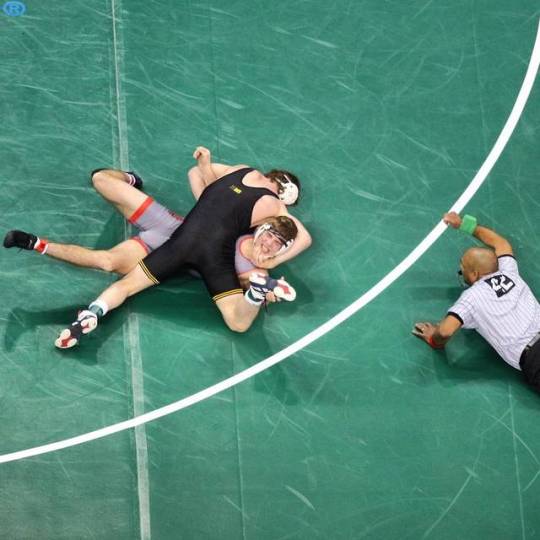
Athlete: Sammy Brooks. 184-lb weight class Team: University of Iowa Hawkeyes Wrestling Event: 2017 NCAA Division I Wrestling Championships. Session 2. Thursday, March 16, 2017. Location: Scottrade Center. St. Louis, Missouri. Result: Brooks pins Edinboro's Dakota Geer at 3:44 in their second round bout on Thursday evening. Brooks improved to 26-2 for the season. @ncaawrestling @ncaasports @hawkeye_wrestling #ncaawrestling #ncaawrestlingchampionships #ncaachampionships #wrestling #instawrestling #NCAA #athleteseyephotography http://ift.tt/2mA9hhv
0 notes
Photo
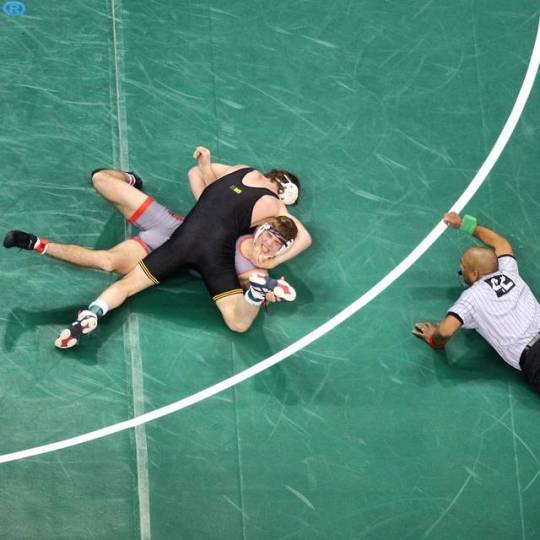
Athlete: Sammy Brooks. 184-lb weight class Team: University of Iowa Hawkeyes Wrestling Event: 2017 NCAA Division I Wrestling Championships. Session 2. Thursday, March 16, 2017. Location: Scottrade Center. St. Louis, Missouri. Result: Brooks pins Edinboro's Dakota Geer at 3:44 in their second round bout on Thursday evening. Brooks improved to 26-2 for the season. @ncaawrestling @ncaasports @hawkeye_wrestling #ncaawrestling #ncaawrestlingchampionships #ncaachampionships #wrestling #instawrestling #NCAA #athleteseyephotography http://ift.tt/2mA9hhv
0 notes
Text

Dakota Geer
21 notes
·
View notes